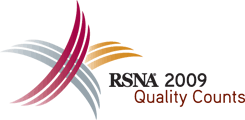
Abstract Archives of the RSNA, 2009
SSK17-02
Evaluation of MRI in the Follow-up for Pyogenic Spinal Infection in Children
Scientific Papers
Presented on December 2, 2009
Presented as part of SSK17: Pediatrics (Musculoskeletal)
Qiu Yan Wang, Presenter: Nothing to Disclose
Paul S. Babyn MD, Abstract Co-Author: Nothing to Disclose
Helen Maree Branson FRACR, MBBS, Abstract Co-Author: Nothing to Disclose
Dat Tran, Abstract Co-Author: Nothing to Disclose
Jorge Humberto Davila Acosta MD, Abstract Co-Author: Nothing to Disclose
Edrise Lobo-Mueller, Abstract Co-Author: Nothing to Disclose
Although uncommon, pediatric pyogenic spinal infections can cause severe and long lasting neurologic complications. Our aim is to evaluate serial spinal MRI changes and the impact of follow-up MRI on clinical management.
All pediatric (< 18 years) patients with pyogenic spinal infection over a 9-year period with multiple MRIs after antibiotic treatment were included.
Features of spinal infection including marrow edema, disc abnormality, bone destruction, paraspinal or epidural involvement and abscess were assessed. Imaging was reviewed by 2 radiologists blinded to patients’ clinical information. Demographics, clinical management and patients’ response were reviewed by an infectious disease physician.
17 patients (2m to 16y, 9F: 8M) with 51 follow-up MRI exams, done 2 weeks to 4.75 years after baseline. Follow-up exams consisted of 35 whole spine and 16 localized spinal scans. 7 patients (< 3 years) underwent 33 follow-up MRI with multiple GAs or sedation.
Follow-up MRI showed initial progress in disc changes but improvement in epidural enhancement, epidural abscess and canal compromise. Infection affected > 1 vertebral level in 13 cases without skip or multifocal lesions. Posterior element infection only was seen in 3 cases. 3 cases of solitary vertebral body involvement on baseline resolved in 1 and progressed to involve adjacent disc and vertebra in 2. 5 cases of epidural and 6 cases of paraspinal abscess completely resolved in 4 each and improved in the rest. Epidural and/or paraspinal soft tissue enhancement showed different degree of improvement in all cases except the only case without satisfactory clinical response. Marrow edema, bony and/or disc changes and paraspinal soft tissue enhancement can be seen on follow-up 1-3 years after baseline MRI, despite patients being symptom-free. Extension of antibiotic treatment was given in 47% patients at least partly based on follow-up MRI.
Vertebral body osteomyelitis without discitis may present in early stage. Osteomyelitis can locate in posterior elements only. Changes in epidural and/or paravertebral soft tissues, rather than bony and/or disc destruction, correlate better with patients’ clinical symptoms. Progression of bony and disc changes can occur despite clinical adequate therapy and response.
Frequency and range of follow-up MRI in clinically responsive patients can be potentially reduced.
Wang, Q,
Babyn, P,
Branson, H,
Tran, D,
Davila Acosta, J,
Lobo-Mueller, E,
Evaluation of MRI in the Follow-up for Pyogenic Spinal Infection in Children. Radiological Society of North America 2009 Scientific Assembly and Annual Meeting, November 29 - December 4, 2009 ,Chicago IL.
http://archive.rsna.org/2009/8016471.html

